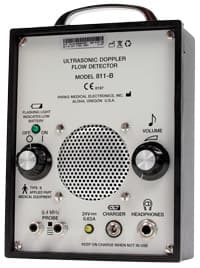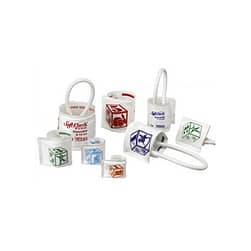Why use a Doppler?
 One of the objectives of anesthesia is to provide adequate blood flow to tissue. One way to assess blood flow is to measure blood pressure (ideally mean blood pressure) and heart rate.
One of the objectives of anesthesia is to provide adequate blood flow to tissue. One way to assess blood flow is to measure blood pressure (ideally mean blood pressure) and heart rate.
Most of the time, in small animal anesthesia, blood pressure is measured non-invasively. It is, however, possible to measure blood pressure invasively to obtain a more precise value. Only non-invasive blood pressure monitoring techniques are explained below. Non-invasive blood pressure can either be monitored with oscillometric devices (PetMap for example) or with a Doppler flow monitor (later call Doppler).
A Doppler only detects flow and makes sounds when the arterial flow changes during each heartbeat. When measuring blood pressure with a Doppler, the principle is to occlude arterial blood flow by inflating a cuff and then deflating it until the flow goes back to normal. When the pressure in the cuff is just below the systolic blood pressure, blood flow can pass the cuff and is detected by the Doppler probe. Heart rate can be calculated with the sounds of the Doppler.
Advantages
- Non-invasive
- Continuous monitoring of heart rate
- Continuous monitoring of hemodynamic changes
Disadvantages
Manual, intermittent measurement of blood pressure
- Only systolic blood pressure measurement
- Data may be false for small patients and cats
- Data may be false in case of arrhythmia
When to use a Doppler?
Hypotension is one of the common risks of anesthesia. Non-invasive blood pressure monitoring is easy and quick to install and should be used for every patient. Blood pressure monitoring can be placed before induction if the level of sedation allows it.
With the Doppler, the sound is heard continuously, and this provides continuous monitoring of the heart rate and the velocity of the blood. Blood pressure, however, can only be measured when inflating the cuff. Ideally, it should be done at least every five minutes.
Systolic blood pressure below 100 mmHg should be a concern. Systolic blood pressure below 80 mmHg is a major concern.








